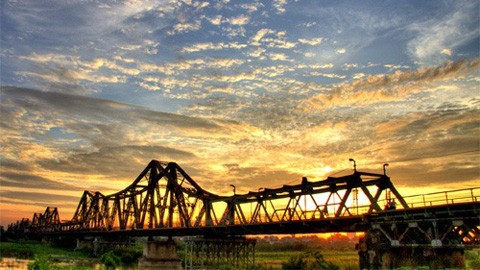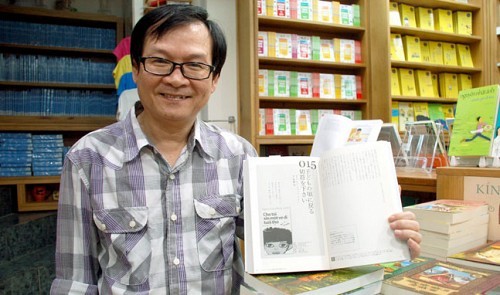A: The most impressive letter this week is from Ashik Eqbal Tokon of Bangladesh. He shared his feelings after viewing VOV’s photo reportage of Long Bien bridge in Hanoi.
B: Oh, the issue of whether or not to remove the 100-year-old Long Bien Bridge to build a modern one has stirred a public discussion among urban planning officials, historians, cultural experts, and ordinary citizens. Let’s read Ashik’s letter, Phuong.
A: Ok, here it is. “While walking on the bridge, I see many villagers and hawkers opening their shops beside the path. It’s very familiar in my country. Fresh vegetables - cauliflower, cabbage, carrots, and potatoes - smell as if I’m in my country. While noticing farmers farming under the bridge, I imagine I’m on the bridge of Jamuna in Bangladesh. A train comes along the middle of the bridge and I notice the engine of this locomotive is not like ours. Then I know I’m on the bridge of Long Bien, Hanoi’s bridge of the poor.”
B: It’s lovely to hear about what he experienced on Long Bien bridge.
A: But he didn’t, really. Ashik said he has never been to Vietnam. He wrote: “While looking at the pictures of this bridge on your website, “The centenary bridge stands the test of time”, I imagine I’m in Vietnam. Thanks for those serial pictures that represent the bridge as real as it is.”
B: It’s interesting that Ashik found a resemblance between Vietnam and Bangladesh when he looked at these photos. I’ll check the internet to see the Jamuna bridge in Bangladesh.

Long Bien bridge (Photo: LenMF) |
A: The Ministry of Transport recently proposed three plans. The first is to build a new bridge exactly where the old one stands, keeping the central part with the railway track intact for historicity. The second option is to build a new, modern bridge with a design similar to the old one. And the third is to upgrade the bridge while retaining parts of the central section and trusses.
B: Personally, I hope the bridge will be upgraded and preserved because it has been one of the most important symbols of the capital city for more than a century.
A: I agree with you. Many large, modern bridges have been built across the Red River, and Long Bien bridge is no longer an important railway bridge. It has become a cultural and historical heritage.
B: I have here an email from regular listener Jayanta Chakrabarty of India. He reported listening to our program on March 1 via the internet. Jayanta said he read a piece of news on VOV’s website about a popular book called “Kinh van hoa” (kaleidoscope) and a collection of short stories “Cho toi xin mot ve di tuoi tho”, called “Give me a ticket to childhood”, by noted Vietnamese writer Nguyen Nhat Anh. The books, translated from Vietnamese into Japanese, have been listed by the high profile Japanese publisher Ten-Books among the “top 105 best-sellers” in Japan.
 |
| Writer Nguyen Nhat Anh |
A: The book “Give me a ticket to childhood”, which blends fond childhood memories with adulthood memories, has been translated into English, Thai, and Korean and published in several countries. The original book has sold some 200,000 copies in Vietnam and has been on the local bestseller list since debuting in 2008. In late 2010, the book earned its author the Southeast Asian Writer Award, which has been awarded since 1979 by the Thai Royal Family to writers from each member state of the Association of Southeast Asian Nations (ASEAN).
B: Nguyen Nhat Anh is among Vietnam’s most successful and prolific children’s writer. His books appeal to children and teenagers, as well as adults. Anh is also a teacher, poet, and journalist. Jayanta said he would like to hear more about this renowned author in one of VOV’s future programs. India knows very little about Vietnamese literature, he said.
A: We will be sure to profile Nguyen Nhat Anh and his stories in a later program. Until then, you can read about him on the internet and find English versions of his books on amazon.com. I should note that Jayanta read the news about Nguyen Nhat Anh in VOV’s online newspaper. But the website of VOV Radio World Service, which includes English broadcasts, is at vovworld.vn. We hope you will take note of that and add our website address to your Favorite’s menu. Thanks you.
B: Reading the letters I realize that most of our listeners are interested in Vietnam’s culture and natural landscapes. They say VOV’s introduction of scenic spots and cultural festivals in Vietnam have inspired them to visit Vietnam one day. American listener Timothy Johnson tuned to our channel on 6175 khz and Indonesian listener Tjang Pak Ning used 12020 khz to listen to the program on February 26. They were interested in information about Son Doong cave, the biggest cave in the world.
A: S.B Sharma of India found our story about Bac Ha market in Lao Cai Province interesting. The market was selected by Serendib magazine of Sri Lanka as one of Southeast Asia’s 10 most famous markets. Due to rapid modernization, many markets have lost their authenticity, but Bac Ha market still retains its identity and uniqueness.
B: Before we go, we want to mention that we received reception reports from Jorge Luis Medina of Venezuela, Jon Gallastegi Emaldi of Spain, and Rajib Kumar Mondal of Bangladesh.
B: Time’s up on VOV’s Letter Box. Once again, thank you for listening and writing to us. We’ll send you QSL cards to confirm your reports soon. We welcome your feedback at: English section, Overseas Service, Radio Voice of Vietnam, 45 Ba Trieu Street, Hanoi, Vietnam. Or you can email us at: englishsection@vov.org.vn. You’re invited to visit us online at www.vovworld.vn, where you can hear both live and recorded programs. Good bye until next time.